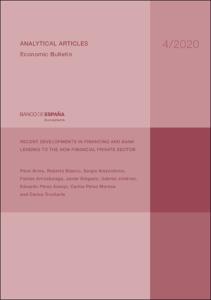Registro completo de metadatos
| Campo DC | Valor |
|---|---|
| dc.contributor.author | Alves, Pana |
| dc.contributor.author | Blanco, Roberto |
| dc.contributor.author | Mayordomo, Sergio |
| dc.contributor.author | Arrizabalaga, Fabián |
| dc.contributor.author | Delgado, Javier |
| dc.contributor.author | Jiménez Zambrano, Gabriel |
| dc.contributor.author | Pérez Asenjo, Eduardo |
| dc.contributor.author | Pérez Montes, Carlos |
| dc.contributor.author | Trucharte, Carlos |
| dc.coverage.spatial | España |
| dc.date.accessioned | 2020-09-29T07:20:10Z |
| dc.date.available | 2020-09-29T07:20:10Z |
| dc.date.issued | 2020-09-23 |
| dc.identifier.issn | ISSN: 1695 - 9086 (online edition) |
| dc.identifier.uri | https://repositorio.bde.es/handle/123456789/13841 |
| dc.description | Artículo de revista |
| dc.description.abstract | The COVID-19 pandemic has significantly altered the financing of the non-financial private sector. Financing of the self-employed and businesses has risen as a consequence of both the increase in demand, stemming from greater liquidity needs and from the perceived increase in refinancing risks, and the expansion of supply, stimulated by the introduction of public guarantee programmes and by the European Central Bank’s policies on the provision of liquidity to credit institutions. In contrast, new lending to individuals has fallen, largely as a consequence of the deterioration in the macroeconomic outlook, which has reduced the supply and demand for credit in this segment. The adverse impact of the COVID-19 crisis on the credit quality of deposit institutions’ portfolios is currently being mitigated by the measures taken by the economic authorities and the institutions themselves (in particular, the public guarantee programme and legislative and banking sector moratoria). However, non-performing loans have increased since the start of the pandemic, both in the case of lending to non-financial corporations and to households. The non-performing loans ratio of deposit institutions has, however, held steady since March, as the expansion in lending (the denominator of the ratio) has offset the increase in the volume of non-performing loans (the numerator). |
| dc.format.extent | 25 p. |
| dc.language.iso | en |
| dc.publisher | Banco de España |
| dc.relation.ispartof | Economic Bulletin / Banco de España, 4/2020 |
| dc.relation.hasversion | Versión en español 123456789/13723 |
| dc.rights | Reconocimiento-NoComercial-CompartirIgual 4.0 Internacional (CC BY-NC-SA 4.0) |
| dc.rights | In Copyright - Non Commercial Use Permitted |
| dc.rights.uri | https://creativecommons.org/licenses/by-nc-sa/4.0/deed.es_ES |
| dc.rights.uri | http://rightsstatements.org/vocab/InC-NC/1.0/ |
| dc.subject | Financing |
| dc.subject | Lending |
| dc.subject | Households |
| dc.subject | Non-financial corporations |
| dc.subject | Deposit institutions, |
| dc.subject | Non-performing loans ratio |
| dc.subject | Public guarantees |
| dc.subject | Moratoria |
| dc.subject | Financial analysis |
| dc.subject | Economic situation |
| dc.title | Recent developments in financing and bank lending to the non-financial private sector |
| dc.type | Artículo |
| dc.identifier.bdebib | 000470149 |
| dc.identifier.bdepub | ECBU-2020-4B-art28 |
| dc.subject.bde | Créditos |
| dc.subject.bde | Teoría monetaría |
| dc.subject.bde | Financiación de la empresa |
| dc.subject.bde | Instituciones crediticias de depósito |
| dc.publisher.bde | Madrid : Banco de España, 2020 |
| dc.subject.jel | E44 |
| dc.subject.jel | E51 |
| dc.subject.jel | G21 |
| dc.subject.jel | G23 |
| dc.subject.jel | G28 |












